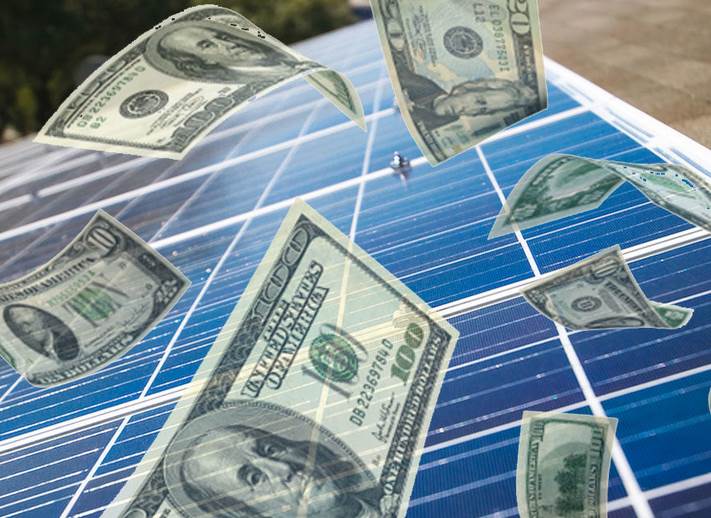1) Eliminate Rising Electric Bills
Let’s face it, your electric bills will continue to rise even if you consume the same amount of electricity each year, over the next 20 years. According to the U.S. Bureau of Labor Statistics, the inflation for electricity grew 2.73% per year.
To visually put that into perspective, let’s examine three scenarios where your average monthly bill ranges from $100, $150, and $250.
That represents an increase in your electricity bill of 66.8%, over 20 years, for the exact same usage. Yikes! Solar energy changes the game completely. Imagine being able to lock in that $100 monthly bill for the next 20 to 25 years. Sounds like a no brainer, right? That takes us right into the second reason to go Solar.
2) Investment Tax Credit (ITC)
The federal government offers a tax credit towards the purchase and ownership of a solar system. From year 2017, the government has been offering a tax credit of 30%! However, the 30% tax credit offered will not offered indefinitely. Starting in 2020, the tax credit will decrease to 26%. See below for a full breakdown.
- 2017 – 2019: Tax credit remains at 30%
- 2020: Tax credit decreases to 26%
- 2021: Tax credit decreased to 22%
- 2022 and Onwards: 10%
In order to take advantage of this amazing tax credit, you should really consider purchasing a Solar system in the next 1-2 years. The drop off in tax credit rises exponentially after 2021, falling to 10%.
What are the qualifications to receive the solar tax credit?
- The system will need to be installed within each respective year to obtain that tax credit percentage.
- Example: The solar system finished installation in October 2021. This would qualify the homeowner for a 22% tax credit.
- You must be the property owner of the home or business unit. Rental properties do not qualify.
- You must own the solar panels; leasing the panels will not qualify you.
But what happens if you choose not to purchase a Solar system. What would you pay in electricity with constantly rising rates? Assuming the same average monthly bills of $100, $150, and $250, plus inflation, your total bill for electricity is listed below
After 20 years, you would have spent a total of $31,373, $40,060, or $78,433 on electricity. Let’s break down each scenario and figure out how much money you would save by going with Solar!
A. Average Monthly Bill $100
The average cost for a solar system that will eliminate an average monthly bill of $100, would cost approximately $15,345. Now let’s apply that juicy tax credit of $4,604 (30%), so our total cost would be $10,742.
By not purchasing a Solar system, you would be paying 292% or $20,632 more!
B. Average Monthly Bill $150
The average cost for a solar system that will eliminate an average monthly bill of $150, would cost approximately $21,651. After applying the tax credit, $6,495 (30%), our total cost would amount to $15,156.
In this scenario, you would pay 311% or $31,904 more!
C. Average Monthly Bill $250
The average cost for a solar system that will eliminate an average monthly bill of $250, would cost approximately $27,959. After applying the tax credit of $8,388 (30%), our cost would total $19,571.
In this scenario, you would pay 401% or $58,862 more!
Imagine all the different possibilities with an extra $20,632, $31,904, or $58,862 in your pocket. As a reminder, this takes a 30% tax credit into play, which by 2022, it dramatically drops off to 10%. Take advantage of this immediately!
3) Increase Your Property Value
The addition of a solar system adds yet another layer of wealth. According to Zillow, the average home in the US saw a 4.1% increase in property value. The median price of homes in the US market at the end of August 31st, 2019 was $237,000, which translates to an additional $9,717.
This benefit would be realized instantly once the installation is complete. So, what would our costs looks like if we were to factor this added property value? Well, with an average monthly bill of $100, we had a tax credit of approximately $4,604, which brought the cost of a solar system down to $10,742. Add in the property value of $9,717 that you gained with a solar system and your costs essentially became $1,025! It cost you a measly $1,025 to eliminate your electricity bill. That’s a return of 1,497% over the next 20 years.
Another added benefit is that homes with solar systems tend to sell 20% faster than homes without. That means when you are finally ready to pack up and move on to a new opportunity, you can rest assured that you’ll be able to sell your property for a higher premium and much quicker! For some people, that could mean not having to pay two mortgages because they had to pursue a better opportunity but couldn’t wait for their home to sell. For others, that could mean capitalizing a higher premium in the housing market before it slows further. You might be saying, but what if I never sell. You still get to wake up every morning knowing that you’re no longer paying for electricity while your neighbor’s rates are increasing every year.
4) Cleaner Air
Solar systems directly improve the quality of air that you breathe. As we all move towards renewable sources of energy, such as solar, we reduce the amount of carbon emissions that get released into the air. Carbon emissions, in large amounts, can increase the global temperature. This causes ozone production to increase in urban areas. Ozone can turn into a highly corrosive gas, especially when water vapors get introduced. Above certain levels it will directly kill lung cells.
According to a Stanford University study, carbon emissions increase temperature, and for every one-degree Celsius increase, it would cause many more cases of respiratory illness and asthma. There are huge financial benefits to going solar, but there is no price tag on health and well-being.
Did you know that residential and commercial buildings account for approximately 39% of carbon emissions in the United States? Many people may think its only cars and airplanes that produce carbon emissions. Buildings indirectly produce carbon emissions. The electricity that is consumed must be produced at various plants, which in turn release carbon emissions into the atmosphere. By installing a solar system, you’re taking an active step to make the air cleaner for yourself, your friends, and even your dog because we end up relying less on fossil fuels for energy.
5) Better for the Environment
As mentioned earlier, residential homes account for 39% of carbon emissions in the United States. The way this happens is through direct usage of electrical energy in the home. The two largest components are heating and cooling. Did you know that for every kilowatt hour used in the home that approximately 0.954 pounds of carbon get released into the air from a power plant?
By adding a solar system to the home to eliminate the need to rely on energy generation from a power plant, that is equivalent of planting 100 years annually. What kind of a world do you want to live in?












